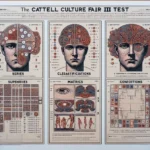The Cattell Culture Fair III is a groundbreaking psychological assessment tool designed to evaluate an individual’s cognitive abilities without the influence of cultural bias or language barriers. Named after its creator, renowned psychologist Raymond B. Cattell, the Culture Fair Intelligence Test (CFIT) has evolved over the years, with the third iteration – Cattell Culture Fair III, being the most sophisticated and widely used version today.
This non-verbal intelligence test has become a cornerstone in the field of psychometrics due to its ability to provide an equitable measure of intelligence. It’s particularly useful for assessing the intelligence of individuals from diverse cultural backgrounds, educational environments, and linguistic groups. In this article, we will delve into the importance, application, and benefits of the Cattell Culture Fair III.
Importance of a Culture Fair Test
The need for a culture-fair test stems from the understanding that traditional IQ tests often contain cultural and linguistic biases that can unfairly advantage or disadvantage test-takers from particular backgrounds. The Cattell Culture Fair III is designed to eliminate this bias by focusing on non-verbal reasoning and problem-solving skills. The test’s neutral content ensures that individuals of varied educational and cultural experiences can be fairly assessed.
The Cattell Culture Fair III features a series of abstract reasoning puzzles that are not dependent on language comprehension or specific cultural knowledge. This means that the test is particularly suitable for assessing intelligence in a multicultural society, identifying gifted children and adults in diverse populations, and ensuring fair recruitment and selection processes in global organizations.
Components and Structure of the Test
The Cattell Culture Fair III is comprised of four scales – three for adults and one specifically for children. Each scale consists of multiple subtests that measure different dimensions of non-verbal intelligence. The overall structure of the test is designed to assess a broad range of cognitive abilities, such as fluid intelligence, spatial reasoning, and problem-solving skills.
The adult scales generally include subtests on series, classifications, matrices, and conditions. Each of these subtests challenges the individual’s ability to recognize patterns, classify objects based on abstract criteria, solve visual puzzles, and apply logical thinking to novel situations.
Applications of the Cattell Culture Fair III
The impact and usefulness of the Cattell Culture Fair III are widespread. In educational settings, it helps to identify gifted and talented students who may not perform well on traditional intelligence tests due to language or cultural differences. It also promotes equity in the educational system by providing a fair assessment tool for students from various backgrounds.
In the workplace, human resource professionals utilize the Cattell Culture Fair III during the hiring process to ensure that candidates from all cultural backgrounds are given an equal opportunity to demonstrate their true cognitive abilities. It also helps businesses in building teams with diverse cognitive strengths, enhancing creativity and problem-solving in the organization.
Additionally, researchers and clinicians find the Cattell Culture Fair III invaluable in studying cognitive processes across different populations without language or cultural confounds. It aids in the diagnosis of learning disabilities and cognitive impairments while allowing for comparisons between diverse groups on an even playing field.
Benefits of the Cattell Culture Fair III
The primary benefit of the Cattell Culture Fair III is its inclusivity. By removing cultural and linguistic biases, it ensures that individuals are assessed based on their true intelligence and not their familiarity with a particular language or culture. This level of fairness and accuracy is not typical in standard IQ tests.
The comprehensive nature of the test also allows for a detailed profile of an individual’s cognitive strengths and weaknesses. This can inform tailored educational programs, career guidance, and personal development plans. For organizations, this means that they can more effectively place individuals in roles that match their cognitive capabilities, leading to increased job satisfaction and productivity.
Moreover, the use of the Cattell Culture Fair III can contribute to social justice by providing all individuals with an equal chance to demonstrate their intellectual potential. It plays a vital role in breaking down barriers that can be imposed by culturally-biased assessments, enabling a merit-based system that recognizes talent and potential regardless of cultural background.
Preparing for the Cattell Culture Fair III
While the Cattell Culture Fair III is designed to minimize biases, preparing for the test can help individuals become familiar with the types of questions and the format. There are practice materials and sample tests available that can be used to build confidence and reduce anxiety when taking the actual assessment. However, due to the nature of the test, excessive preparation is not required and can even be counterproductive, as the test aims to measure innate cognitive abilities.
In summary, the Cattell Culture Fair III serves as a critical tool in the measurement of intelligence across cultural divides. It offers a non-biased and accurate assessment of an individual’s cognitive capabilities, leading to fairer educational practices, more equitable workplaces, and improved societal outcomes. Its design and application speak volumes to the movement towards a more inclusive and just world, where everyone’s potential can be recognized and nurtured.

